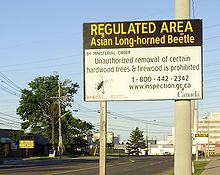 Yesterday, the Asian longhorned beetle Anoplophora glabripennis (ALB), a highly invasive wood-boring insect from China was finally declared eradicated in Canada by the Department of Agriculture and Agrifood. The beetle was last detected in Canada in the Toronto-Vaughn area of Ontario in 2007 (see map below), which fulfills the 5-year Canadian requirement for eradication of an invasive insect with a 1-2 year life cycle.
Yesterday, the Asian longhorned beetle Anoplophora glabripennis (ALB), a highly invasive wood-boring insect from China was finally declared eradicated in Canada by the Department of Agriculture and Agrifood. The beetle was last detected in Canada in the Toronto-Vaughn area of Ontario in 2007 (see map below), which fulfills the 5-year Canadian requirement for eradication of an invasive insect with a 1-2 year life cycle.The eradication program, which was led by the Canadian Food Inspection Agency (CFIA) and the Canadian Forest Service, with support from the province of Ontario, the City of Toronto, academia, and the United States Department of Agriculture saw the removal and disposal of 28,700 trees, which were hosts for ALB (including maple, birch, willow, and elm). Although this seems like a silly way to manage an infestation, at the time there were no registered pesticides to kill the beetle larvae - which cut off the tree's circulation by boring into the wood - so removal was the only way to protect the rest of the province and country from the impact that the insect could have on both urban and natural forests.
CFIA also set regulations and quarantines to limit new introductions and spread. These were phytosanitary requirements requiring heat treatment of all imported wood packaging as well as setting a quarantine around the generally infested area and buffer to restrict the movement of potentially infested maple, birch, elm, and willow wood from being moved outside of the quarantined area.
The management around the Asian longhorned beetle is seen as the poster child of a successful invasive species eradication program. The biology of the beetle, including its large and distinctive body and antannae and its slow spread, facilitated the early identification and control of the beetle, but the great collaboration between partners, quick action, and science at the forefront of management decisions, ensured a successful response.
 The Asian longhorned beetle is still infesting trees in the United States, in New York, New Jersey, and Massachusettes and has the potential to be reitroduced into Canada as the beetle larvae hitch-hike on products imported into Canada from the United States and internationally.
The Asian longhorned beetle is still infesting trees in the United States, in New York, New Jersey, and Massachusettes and has the potential to be reitroduced into Canada as the beetle larvae hitch-hike on products imported into Canada from the United States and internationally. In the meantime, forest managers are kept busy with other invasive forest insects, like the emerald ash borer, the brown spruce longhorn beetle, or the native mountain pine beetle, that no longer undergoes intense winters to keep its population in check.
Whether its trade or climate change, biological invasions will be repeated and the cost of an eradication program - over $23 million for that of Asian longhorned beetle, for example, is a good enough reason to avoid similar cases in the future. It should also be noted that eradication is not always a possiblity, as is the case for species that were discovered after becoming widely established, are too difficult to detect, or where treatment would be too costly.
 So knowing that it doesn't always work out when we react after the fact, how can we better prepare against new infestations?
So knowing that it doesn't always work out when we react after the fact, how can we better prepare against new infestations? To start, we can rethink the way we trade and move products. Do we really need to move firewood across the province or country or do we absolutely need to have a plant shipped from China, because its flowers are slightly pinker than the native variety? When it comes down to it, unless that plant has some magical powers, it probably isn't worth $23 million.
In addition, we can better manage our urban forests for diversity and health. Although some species are generalists, most species feed on specific plants either exclusively or as a preference and are in many cases more attracted to stressed hosts. If we diversify and ensure adequate planting space of the tree species, we limit the pest's food source and the number of trees that will need to be treated or replaced were the pest to establish.
So, we can all do our part in preventing the movement and introduction of invasive species, because there's a reason that the Asian longhorned beetle, although a true success, is more of an anomaly than a common occurance.
For more information about the Asian longhorned beetle, visit the Canadian Food Inspection Agency's or Ontario Ministry of Natural Resources public sites.
Photo credits go to the Canadian Food Inspection Agency, Canadian Border Service Agency, and Wikimedia commons.

No comments:
Post a Comment